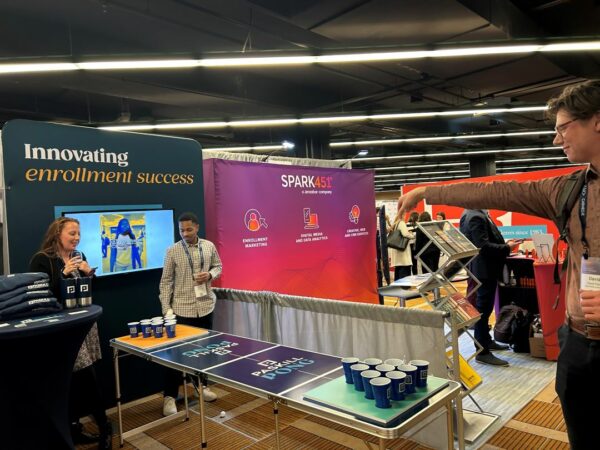Building Community and Embracing Change, Key Messages at AMA

Belonging doesn’t just matter to today’s prospective college students; it matters to all of us, even higher ed marketing professionals looking to evolve in a competitive marketplace.
For the 1,500 higher ed marketers that attended AMA’s Symposium for the Marketing of Higher Education in Chicago last month, a sense of community was cultivated, especially around issues impacting all institutions.
Issues like enrollment, DE&I, brand relevancy, shifting audience preferences, change management, AI impact and integration, and content strategy to name a few.
According to longtime enrollment marketer Jim Paskill, the energy in Chicago was contagious. “This year’s record attendance was a testament to the fact the higher education community thrives on getting together to exchange ideas to advance the entire industry.”
Building community is also about making space to play together.
Enrollment marketing agency Paskill has been sponsoring and presenting at AMA for decades; this year more fun was infused into the firm’s booth presence with a variation of a game popular with a demographic colleges seek to engage: cup pong.
Dozens of representatives from institutions like University of Pittsburgh, American University, Cornell University, and University of Arizona tried their hand at Paskill Pong showing skills or learning new ones, while talking about marketing goals on campus or ideas sparked at the conference.
A friendly tournament and positive conference experience led to first-time AMA attendee Keiko Arzouman from Chapman University to return to campus energized and sporting the Paskill Pong trophy.
Community also comes from sharing lived experiences.
Keynote speaker Tia Brown McNair, executive director for the Truth, Racial Healing and Transformation (TRHT) Campus Center reminded attendees that there is a war on DEI and the relevancy of higher ed and marketers need to own that narrative to the public and to students.
“Our audiences need to understand the why of what we do,” she challenged attendees. For students, she says, that’s not just getting high grades in the hopes of employment but also understanding why what they are learning in class matters to solving real problems in their lives and the world.
Navigating change is part of higher education, embrace what’s next.
A panel discussion on “Staying Strategic Through Constant Change” was quickly described as a “250-person therapy session” as speakers shared the high volume of leadership and organizational changes on campus and ways for marketers to stay positive, and productive.
Exceling during times of change was also a keynote topic delivered by “Master of Change” author Brad Stulberg. “Try to model change yourself,” he advised attendees. “The biggest shift is that you don’t have to like change. University leaders don’t have to like change, but they’ve got to accept it,” Stulberg advised.
Embracing change – from state demographics to student preferences – is a major component to the success of Texas State University’s new brand. In the “Building a Next-Generation Brand” session, Elias Martinez, assistant vice president for marketing, discussed shifting brand elements and campaigns toward what students engage with now.
From lifestyle brand influencers to apparel trends to organic social events, the TXST NEXT brand campaign won high industry praise from embodying the idea of distinction over differentiation. “Standing out with impact so that consumers can easily identify, recall and buy the brand.”
Growth during times of change is possible with the right support.
For many institutions to stand out in the marketplace is daunting with the demands of the day. In the roundtable discussion Paskill sponsored, “Managing Up, Down and Sideways” more than 100 attendees participated to share how their roles as communicators and marketers require constant navigation to be effective in their roles.
Co-led with Nicole Szymczak, senior director of communications and marketing at Michigan State University Health Sciences, the roundtable allowed attendees to feel united in the growing demands and challenges on higher ed marketers.
“My favorite feedback from new attendees was the joyful realization they were not alone,” Szymczak shared. “‘I found my people,’ a few told us.”
Support from colleagues is key to building awareness and stamina in your role as a higher ed marketer, but support can also come from an agency partner that can provide solutions and capacity not always possible in house.
“We invest in conferences like AMA because we know the value of community and professional development,” adds Paskill. “It’s also a way for agencies like us to be available for conversations during the event and to build relationships long after.”